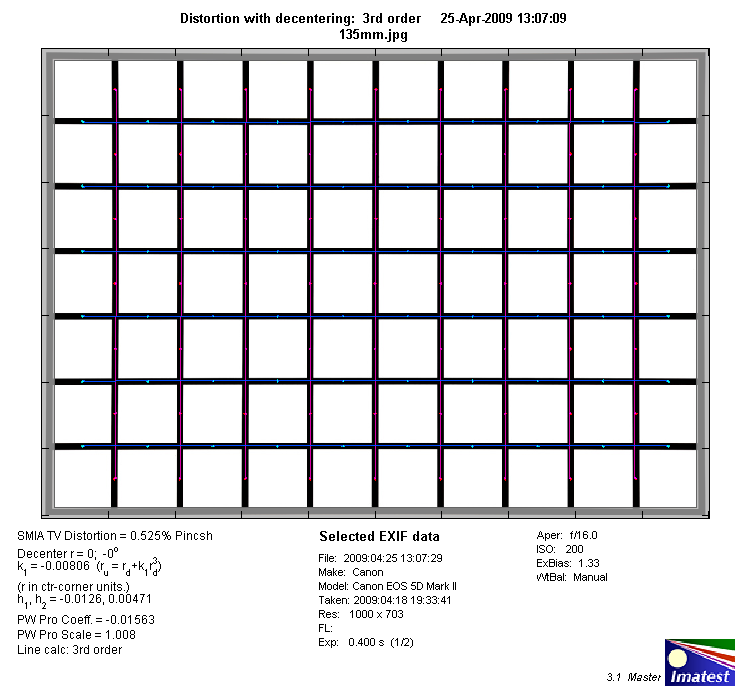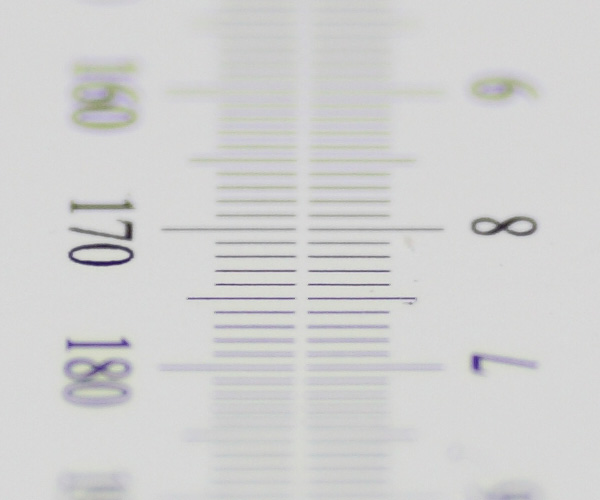|
Canon EF 135mm f/2 USM L (full format) - Review / Test Report - Analysis |
|
Lens Reviews -
Canon EOS (Full Format)
|
|
Page 2 of 3

Distortion
The Canon lens produces a comparatively mild degree of pincushion distortion (0.5%) which is usually not field relevant.

Vignetting
Full format sensors are difficult beings with respects to vignetting and even the mighty Canon EF 135mm f/2 USM L has its problems here. At around 1.5EV @ f/2 the situation isn't overly dramatic but this degree of vignetting is often visible in field conditions. However, stopping down to f/2.8 solves most of the problem and it's pretty much negligible by f/4. This is a comparatively good performance for an ultra large aperture lens here.

... and here's a visual ...
| f/2 |
f/2.8 |
 |
 |
MTF (resolution)
The EF 135mm f/2 USM L produced very high resolution figures in the MTF lab. The center is already excellent at max. aperture and the border quality is only one mark behind. The quality improves gradually from here on and it reaches its peak around f/5.6 where the resolution is excellent across the image frame. Diffraction reduces the quality level from f/8 onwards but it remains easily on a very good level at f/11.
Please note that the MTF results are not directly comparable across the different systems!
Below is a simplified summary of the formal findings. The chart shows line widths per picture height (LW/PH) which can be taken as a measure for sharpness.
If you want to know more about the MTF50 figures you may check out the corresponding Imatest Explanations

Chromatic Aberrations (CAs)
Similar to many other high-end tele prime lenses lateral CAs (color shadows at harsh contrast transitions)
are very low and really nothing to worry about.

Bokeh
The bokeh (quality of the out-of-focus blur) is a major performance criteria for a large aperture lens and the EF 135mm f/2 USM L does not disappoint us here. Out-of-focus highlights are exceptionally smooth and even and they are perfectly circular at f/2 - at least a little inward from the corners (they deteriorate a little towards an elliptical shape here). The highlights remain pretty much circular at f/2.8 whereas you can spot the first aperture edges at f/4. The quality of the blur is very smooth. All-in-all an excellent quality here.

Bokeh Fringing / Longitudinal Chromatic Aberrations (LoCA)
Some readers in our forum expressed the hope the this lens is a true APO design. Unfortunately this is not the case. It suffers from LoCAs (non-coinciding focal planes of the various colors), sometimes also called bokeh fringing. As you can see below the focus halos have different colors - magenta (red + blue) in front the focus point and green beyond. Truly "apochromatic" lenses don't show LoCAs but these lenses are very rare and usually insanely expensive. Unlike lateral lateral CAs, LoCAs cannot easily be fixed in post processing.
Typical for most fast primes the 135mm L shows a considerable amount of LoCAs at large aperture settings (which can be field relevant in critical scenes). Stopping down helps to reduce the amount of LoCAs significantly but it takes till f/4 to eliminate the problem. Please note that this may not be perfect but even the brand new Zeiss ZA 135mm f/1.8 shows the same characteristics here.
|
Move the mouse cursor over the f-stop marks below to observe the respective LoCAs
|
| f/2 |
f/2.8 |
f/4.0 |
f/5.6 |
|

|
|